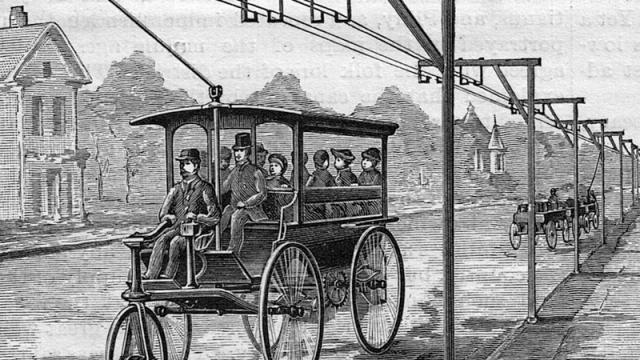This “electric carriage” which appeared in the 27 July 1889 issue of Scientific American was way ahead of its time. How ahead of its time was it? South Dakota wasn’t even a state yet. The article that went along with it noted that the patent for this ingenious contraption was granted to one Mr Harvey D. Dibble of Rapid City, Dakota Territory.
The “electrically propelled carriage”, scanned from the 27 July 1889 issue of Scientific American magazine
Of course, North and South Dakota weren’t the only things that hadn’t been invented yet. Newfangled contraptions like the free-wheeling internal combustion automobile were still a few years out.
As you can see from the illustration above, the vehicle was essentially an electric car, powered by overhead electric wires. It had some mobility in that if it needed to avoid an obstacle, the driver could steer it out of the way and still be connected to the electricity above. Pretty damn neat.
From the 27 July 1889 issue of Scientific American:
The accompanying illustration represents the applications of a system of electrical propulsion for common roads, by means of which traffic is designed to be carried on without employing a railroad track, the steering gear being so arranged that the wagon will automatically run parallel with the line of the conductors.
It has been patented by Mr. Harvey D. Dibble, of Rapid City, Dakota Territory. The wagon body to which this improvement is applied is partly supported on a caster wheel, provided with a fork, journaled in the forward end of an extension of the frame of the body. Upon the rear axle, in this case carrying the drive wheels, is mounted a spur wheel engaged by a pinion on the armature shaft of a motor secured to the main frame of the body. Above the road bed are suspended electrical conductors, supported by poles and brackets, and each wagon is provided with a trolley which rides upon a pair of the conductors, whereby connection is made between the motor and conductors, through a vertical shaft, the electrical switch being close to the driver. The driver’s seat is supported on the forward extension of the body, where he is able to guide the wagon by turning the caster wheel in one direction or the other. Ordinarily the wagon will run in a line parallel with the conductors, the trolley following any deviations from a straight line, and the driver not being required to use the steering lever except when it is needful to turn aside, when the wagon can be made to run in a new line according to the position in which the driver places the steering lever. The yielding nature of the connection between the wagon and the trolley is such as to permit one wagon to turn out for another upon the road, or permit a wagon to run continuously on one side of the conductors. A wagon of this description, having an electric motor of sufficient capacity, may also, carrying its own load, draw a train of other loaded wagons.
Both North and South Dakota were granted statehood on 2 November 1889, so it wasn’t too long after this issue of Scientific American came out. Plenty of cities would see versions of this kind of mass transit invade their cities, of course. Most ambitiously perhaps in the trolleybuses that would serve London starting in the 1930s. But this is the first vision of this specific type of transportation that I’m aware of showing up anywhere in print.
So our hats are off to you, Mr Dibble, resident of the Dakota Territory. A futurist visionary and a gentleman. (I don’t know if he was a gentleman. He could’ve been a no-good scallywag for all I know.)
